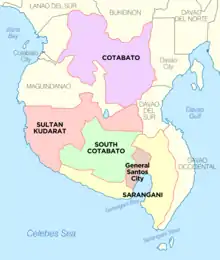South Cotabato
| |
|---|---|
| Province of South Cotabato | |
| Other transcription(s) | |
| • Jawi | سلاتن كوتوات |
   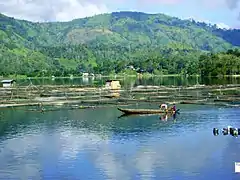 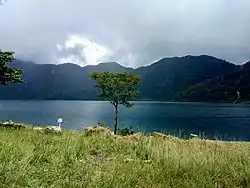 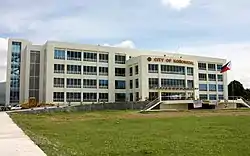 (from top: left to right) Lake Holon, Seven Falls in Lake Sebu, Mount Matutum, Lake Sebu, Lake Holon in T'boli and Koronadal City Hall. | |
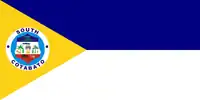 Flag  Seal | |
| Nickname: Land of the Dreamweavers | |
 Location in the Philippines | |
OpenStreetMap | |
| Coordinates: 6°10′N 125°00′E / 6.17°N 125°E | |
| Country | Philippines |
| Region | Soccsksargen |
| Founded | July 18, 1966 |
| Capital | Koronadal |
| Largest city | General Santos |
| Government | |
| • Type | Sangguniang Panlalawigan |
| • Governor | Reynaldo S. Tamayo Jr. (PFP) |
| • Vice Governor | Arthur Y. Pingoy Jr. (PFP) |
| • Legislature | South Cotabato Provincial Board |
| Area | |
| • Total | 3,935.95 km2 (1,519.68 sq mi) |
| • Rank | 32nd out of 81 |
| (excluding General Santos) | |
| Highest elevation | 2,286 m (7,500 ft) |
| Population (2020 census)[2] | |
| • Total | 975,476 |
| • Rank | 29th out of 81 |
| • Density | 250/km2 (640/sq mi) |
| • Rank | 41st out of 81 |
| (excluding General Santos) | |
| Divisions | |
| • Independent cities | 1
|
| • Component cities | |
| • Municipalities | |
| • Barangays |
|
| • Districts | |
| Time zone | UTC+8 (PST) |
| ZIP code | 9500–9513 |
| IDD : area code | +63 (0)83 |
| ISO 3166 code | PH-SCO |
| Spoken languages | |
| Income classification | 1st class |
| Website | www |
South Cotabato (Hiligaynon: Bagatnan Cotabato; Cebuano: Habagatang Cotabato; Maguindanaon: Salatan Kutawatu, Jawi: سلاتن كوتوات; Filipino: Timog Cotabato[3]), officially the Province of South Cotabato, is a province in the Philippines located in the Soccsksargen region in Mindanao. Its capital is Koronadal, and it borders Sultan Kudarat to the north and west, Sarangani to the south and northeast, and Davao del Sur to the far northeast. To the southeast lies Sarangani Bay.
General Santos, located on the shores of Sarangani Bay, is the most populous city in both the province and the region, but is governed independently from the province. The province of Sarangani used to be part of South Cotabato until it was made an independent province in 1992.
History
Early history
Centuries ago, the area that would be the South Cotabato was sparsely inhabited by Maguindanaon pioneers and Lumads which are under Sultanate of Maguindanao's influence. The Spaniards launched expeditions to subdue the area throughout the colonial era but they never gained control of the region until the middle of the 19th century after the Spaniards established a military post at what is now Barangay Tamontaka, one of the earliest Christian settlements founded south of the Philippines, in present-day Cotabato City. Spaniards already took with them Chavacano-speaking Christians and Muslims from Zamboanga and Basilan, as well as the Visayans, especially the Hiligaynons and Cebuanos.
American invasion era
The area of what is now South Cotabato and Sarangani provinces used to be part of Davao province until 1914, when the reorganization of the districts in Mindanao took place, thus it became part of the then-undivided Cotabato province. Settlers, who would lay the foundation of what would become a progressive province, started trooping down 1914.
The significant thrust occurred during the term of President Quezon in late 1930s. General Paulino Santos led the first of wave of settlers that time.
Philippine independence
After World War II, the final exodus of settlers from Luzon and Visayas poured into the area's virgin land. In the early 1960s as population, trade and industries grew in southern part of Cotabato, a clamor of local self-governance arose. Thus, on July 18, 1966, South Cotabato was separated from Cotabato as an independent province.[4] At that time, the province consisted of 11 municipalities, namely: Banga, South Cotabato, General Santos (now a city), Glan, Kiamba, Koronadal, Maitum, Norala, Polomolok, Surallah, Tantangan, and Tupi. These municipalities were established long before the creation of the province. Other component municipalities were formed after it fully functioned as a province.
With the creation of regions under Pres. Ferdinand Marcos, South Cotabato was grouped with Region XI, also known as Southern Mindanao, in 1975.[5]
In 1992, the province of Sarangani was formed out of South Cotabato. Seven towns in southern and coastal section of the province (Malungon, Alabel, Malapatan, Glan, Maasim, Kiamba and Maitum) became part of the new province, leaving South Cotabato with 11 remaining municipalities.[6]
Regional offices were relocated to South Cotabato in accordance with EO 429 dated October 12, 1990, issued by President Corazon C. Aquino during the expansion of the newly created Autonomous Region in Muslim Mindanao,[7] and EO No. 36 dated September 19, 2001, issued by President Gloria Macapagal Arroyo which says South Cotabato is to be transferred from Southern Mindanao region to Region XII and having the city of Koronadal as the regional center of Region XII.[8]
Contemporary
On August 16, 2000, Republic Act No. 8803 was approved, that converted the municipality of Koronadal into a component city of South Cotabato.[9]
In 2015, the National Competitiveness Council declared the province as the 4th most competitive province in the country.
Geography
South Cotabato covers a total land area of 3,935.95 square kilometres (1,519.68 sq mi).[10] When General Santos is included for geographical purposes, the province's land area is 4,428.81 square kilometres (1,709.97 sq mi).[10] The province is situated on the southern section of central Mindanao, bounded by the provinces of Sultan Kudarat to the north and west, Sarangani to the south and northeast, Davao del Sur to the far northeast, and the Sarangani Bay to the southeast.
The province is generally flat dotted with some hills and mountains.
Climate
South Cotabato belongs to the fourth type of climate, that is rainfall is more or less evenly distributed throughout the year. The average number of rainy days for the year 2004 is recorded between 122 and 180 days with the months of May, June, July, August and October having the most occurrence.
Air humidity generally follows closely the rainfall pattern. Humidity is highest during the period of June to October with 88% being recorded at the Tupi seed farm. The months of February and April have the lowest air humidity recorded at about 72%.
Maximum daytime temperature throughout the province is in the range of 36 to 38 °C (97 to 100 °F), falling to 23 to 32 °C (73 to 90 °F) during the night depending on the elevation. The hottest period is January to April while July to December being the coolest.
South Cotabato enjoys a mild, pleasant climate with no pronounced dry or wet season, and is practically typhoon-free.
Administrative divisions
South Cotabato comprises 10 municipalities and 1 component city. The highly urbanized city of General Santos is traditionally grouped with, but administered independently from the province. There are 225 barangays (including the city of Koronadal).
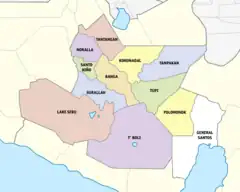
- † Provincial capital and component city
- Municipality
- ‡ Highly urbanized city (geographically within but independent from the province)
| |||||||||||||||||||||||||||||||||||||||||||||||||||||||||||||||||||||||||||||||||||||||||||||||||||||||||||||||||||||||||||||||||||||||||||||||||||||||||||||||||||||||||||||||||||||||||||||||||||||||||
Demographics
| Year | Pop. | ±% p.a. |
|---|---|---|
| 1903 | 30,774 | — |
| 1918 | 42,787 | +2.22% |
| 1939 | 58,224 | +1.48% |
| 1948 | 102,860 | +6.53% |
| 1960 | 136,609 | +2.39% |
| 1970 | 252,612 | +6.33% |
| 1975 | 329,534 | +5.48% |
| 1980 | 401,705 | +4.04% |
| 1990 | 539,458 | +2.99% |
| 1995 | 621,155 | +2.68% |
| 2000 | 690,728 | +2.30% |
| 2007 | 767,255 | +1.46% |
| 2010 | 827,200 | +2.78% |
| 2015 | 915,289 | +1.95% |
| 2020 | 975,476 | +1.26% |
| (excluding General Santos) Source: Philippine Statistics Authority[11][12][12] | ||
The population of South Cotabato (excluding General Santos) was 975,476 in the 2020 census,[11] making it one of the country's most populous province. The population density is 250 inhabitants per square kilometre or 650 inhabitants per square mile.
When General Santos is included for geographical purposes, the province's population is 1,509,735 people,[11] with a density of 341 inhabitants per square kilometre (880/sq mi).
Inhabitants
The people of South Cotabato have diverse heritages. The province's indigenous people are Blaan, Tboli and Maguindanaon. Ethnic Hiligaynons, descendants of migrants from Panay and Negros in the Visayas who settled in the municipalities/towns of Norala, Banga, Surallah, Santo Niño and the province's capital city, Koronadal, are the majority in the province. The province's major media of communication are Hiligaynon, Tagalog, and English. On the other hand, Ilocano-speaking peoples of Luzon settled in Tampakan, Tantangan and Tupi, and the Ilocano language may still be heard in these towns. The Cebuanos are the main ethnic group of the municipality of Polomolok, and are one of the main ethnic groups of Tupi (along with the Hiligaynons and Kapampangans). Both towns are near to General Santos, which speaks both Hiligaynon and Cebuano. Chavacano speakers are even found scattered in some areas of the province, as well as Maguindanaons because of the province's history of being part of Sultanate of Maguindanao. Tbolis mainly reside around the Lake Sebu area, while Blaans reside within General Santos and its outskirts.
Religion
Roman Catholics predominate the province with 65% adherence,[14] while Islam is a minority religion which is 6% of the population.[15] Other minorities are various Christian Churches such as Prostestants which form about 22% and consist of mostly evangelicals[16][13] of the province's population which can be mostly found in some urban parts of the province. Iglesia ni Cristo forms about 3-4% population.[17] The remainder are divided among Buddhist and animism.
The Maguindanaon make up the majority of the Muslim population in the province. Other indigenous Filipino tribes are the T'boli and B'laan tribes in Lake Sebu and T'boli municipalities, famous for their brassworks, beadwork and t'nalak weave. The people of these tribes wear colorful embroidered native costumes and beadwork accessories. The women of these tribes, particularly, wear heavy brass belts with brass 'tassels' ending in tiny brass bells that herald their approach even when they are a long way off.
The people of South Cotabato retain many of the practices and traditions of their particular tribal heritages, although infused with a flavor that is distinctly Mindanaoan and the product of cultural interaction between the immigrants and the indigenous peoples of the area. One vivid example of this is the predominant use of the native malong, the colorful, tubelike garment used as a skirt by the indigenous tribes, in place of a blanket or sleeping bag.
Language
Hiligaynon is the most widely spoken language in the province. It is the main language in the capital city of Koronadal—earning its nickname "the Ilonggo Capital of Mindanao"—and the municipalities of the Upper Valley region, namely, Surallah, Banga, Norala, Sto. Niño and Tantangan, followed by Cebuano, which is the majority language of General Santos and the main language in the Municipalities of Polomolok, Tampakan and Tupi. Tagalog and English are widely understood and often used for administrative functions by the local government and in education, with the former serving as dominant language in local media and of everyday communication of speakers of different languages. Other languages spoken in the province are Maguindanaon, Tboli, Blaan, Kapampangan and Ilocano.
Economy
Government
Executive Branch:[25]
- Governor: Reynaldo S. Tamayo Jr. (PFP)
- Vice Governor: Arthur Y. Pingoy (PFP)
Legislative Branch:[25]
Sangguniang Panlalawigan (Provincial Board Members)
- First District:
- SP Nilda Almencion (PFP)
- SP Noel J. Escobillo (PFP)
- SP Alan Ines (PDP-Laban)
- Second District:
- SP Marie Antonina "Junette" Ines Hurtado (PFP)
- SP Dardanilo N. Dar (PDP-Laban)
- SP Ervin Luntao (PFP)
- SP Mike Matinong (PFP)
- SP Ratrat-Bing Causing (PFP)
- SP Henry L. Ladot (PFP)
- SP Cecile Diel (PFP)
Ex-Officio Members:
- SP Allysa L. Marie Fale, SK President
- SP Rose Grace J. Achurra, PCL President
- SP Edgar G. Sambog, IPMR
- SP Rolando D. Malabuyoc, LnB President
Provincial capital
The Local Provincial Government holds its official functions in the City of Koronadal. The Provincial Capitol, Provincial Hospital, and all related offices are found in the city.
Legislative districts
| District | City | Municipality | Population (2020)[2] |
|---|---|---|---|
| 1st | 287,082 | ||
| 2nd | Koronadal City | 330,306 | |
| 3rd | 358,088 | ||
| Lone | General Santos |
|
697,315 |
- 1st District Representative: Isidro D. Lumayag
- 2nd District Representative: Peter B. Miguel
- Lone District of General Santos: Loreto B. Acharon
House Bill No. 4678, filed on December 13, 2016, by First District Rep. Pedro B. Acharon, Jr., seeks to segregate the highly urbanized city of General Santos from the said district to form its own congressional district, separate from the representation of South Cotabato.[26] This bill was signed by the president last March 11, 2019.
List of governors of South Cotabato since 1967
- 1967 - 1986: Dr. Sergio B. Morales (First Governor of South Cotabato)
- 1986 - 1992: Ismael Sueno (Former Koronadal Mayor)
- 1992 - 2001: Hilario De Pedro III (Former Koronadal Mayor and Congressman)
- 2001 - 2010: Daisy P. Avance - Fuentes (Former Congresswoman)
- 2010 - 2013: Arthur Y. Pingoy, MD (Former Congressman)
- 2013 - 2019: Daisy P. Avance - Fuentes (Former Congresswoman and Governor)
- 2019–Present: Reynaldo Tamayo Jr. (Former Tupi Mayor)
Musical heritage
The native Maguindanaon of South Cotabato have a culture that revolves around kulintang music, a specific type of gong music, found among both Muslim and non-Muslim groups of the Southern Philippines.
Festivals of South Cotabato
Province wide:
- T'nalak Festival - July 9–18 (South Cotabato Foundation Anniversary) [27]
City/Municipalities' festivals:
- Koronadal City - Hinugyaw Festival (January 10),[28] Cityhood Anniversary (October 8)
- Banga - Pasundayag Festival (March 1 Week)
- Lake Sebu - Helobung Festival (November 9–11)
- Norala - Kamayadan Festival (March 10)
- Polomolok - FlomLok Festival (September 10), Pinyahan Festival (Brgy. Cannery Site, Polomolok)
- Sto. Nino - Hinublag Festival (2nd Week of December)
- Surallah - SurbeTube Festival (2nd Week of June )
- T'boli - Seslong Festival (2nd Week of March)
- Tampakan - Tamfaken Lum Alay Festival (June 25)
- Tantangan - Kulitangtang Festival (January 27)
- Tupi - Agfen Tufi Festival (September 1)
Education
There are numerous Higher Educational Institutions in South Cotabato, mostly located Koronadal City.
- Notre Dame of Marbel University, Koronadal
- University of the Philippines Manila School of Health Sciences, Koronadal campus
- South Cotabato State College, Surallah, South Cotabato
- St. Alexis College, Koronadal City
- Ramon Magsaysay Memorial Colleges, Koronadal City
- Green Valley College Foundation, Koronadal City
- STI College Koronadal, Koronadal City
- King's College of Marbel, Inc., Koronadal City
- Notre Dame — Siena College of Polomolok, Polomolok
- Regency Polytechnic College, Koronadal City
- Goldenstate College Marbel, Koronadal City
- Marvelous College of Technology, Inc., Koronadal City
- ACLC College of Marbel, Koronadal City
- South East Asian Institute of Technology, Municipality of Tupi
Notable people
- Kenneth Duremdes, professional basketball player
- Manny Pacquiao, professional boxer and senator
- Gerald Anderson, actor, triathlete and Pinoy Big Brother Teen Edition 3rd Teen Placer
- Melai Cantiveros-Francisco, comedian, actress, host, Pinoy Big Brother Double Up Big Winner and Your Face Sounds Familiar Grand Winner
- Orlando Quevedo, cardinal and archbishop of Cotabato
- Shamcey Supsup, actress, architect and Miss Universe 2011 3rd Runner Up
- Eduardo Buenavista, Filipino long-distance runner and two-time Olympian
- Ismael Sueno, Former Secretary of DILG during Incumbent President Duterte Administration (2016-2017)
- Cesar "Saro" Bañares, Jr., member of folk rock band Asin
- Lovely Abella, actress, host and dancer
Sister province
References
- ↑ "List of Provinces". PSGC Interactive. Makati City, Philippines: National Statistical Coordination Board. Retrieved May 14, 2014.
- 1 2 3 Census of Population (2020). "Region XII (Soccsksargen)". Total Population by Province, City, Municipality and Barangay. Philippine Statistics Authority. Retrieved July 8, 2021.
- ↑ "Mapa ng mga Wika (Rehiyon) - Rehiyon XII" (in Filipino). Commission on the Filipino Language. Retrieved September 23, 2021.
- ↑ "Republic Act No. 4849 - An Act Creating the Province of South Cotabato". Chan Robles Virtual Law Library. Retrieved January 8, 2016.
- ↑ "Presidential Decree No. 742; Restructuring the Regional Organization of Mindanao, Basilan, Sulu and Tawi-Tawi". The LawPhil Project. July 7, 1975. Retrieved January 8, 2016.
- ↑ "An Act Creating the Province of Sarangani" (PDF). House of Representatives of the Philippines. March 16, 1992. Archived from the original (PDF) on February 7, 2016. Retrieved January 8, 2016.
- ↑ "Executive Order No. 429; Providing for the Reorganization of the Administrative Regions in Mindanao, And for Other Purposes". The LawPhil Project. October 12, 1990. Retrieved January 8, 2016.
- ↑ "Executive Order No. 36; Providing for the Reorganization of the Administrative Regions in Mindanao and for Other Purposes". The LawPhil Project. September 19, 2001. Retrieved January 8, 2016.
- ↑ "Republic Act No. 8803; An Act Converting the Municipality of Koronadal, South Cotabato Province, Into a Component City to Be Known As the City of Koronadal" (PDF). House of Representatives of the Philippines. Archived from the original (PDF) on March 3, 2016. Retrieved January 8, 2016.
- 1 2 3 4 "Province: South Cotabato". PSGC Interactive. Quezon City, Philippines: Philippine Statistics Authority. Retrieved January 8, 2016.
- 1 2 3 4 Census of Population (2015). "Region XII (Soccsksargen)". Total Population by Province, City, Municipality and Barangay. Philippine Statistics Authority. Retrieved June 20, 2016.
- 1 2 Census of Population and Housing (2010). "Region XII (Soccsksargen)" (PDF). Total Population by Province, City, Municipality and Barangay. National Statistics Office. Retrieved June 29, 2016.
- 1 2 "Population and People".
- ↑ Bueza, Michael (January 18, 2015). "MAP: Catholicism in the Philippines". Rappler.
- ↑ Bueza, Michael (July 17, 2015). "MAP: Islam in the Philippines". Rappler.
- ↑ "Philippine Church National Summary". philchal.org.
- ↑ Bueza, Michael (July 26, 2014). "MAP: Iglesia ni Cristo in the Philippines". Rappler.
- ↑ "Poverty incidence (PI):". Philippine Statistics Authority. Retrieved December 28, 2020.
- ↑ "Estimation of Local Poverty in the Philippines" (PDF). Philippine Statistics Authority. November 29, 2005.
- ↑ "2009 Official Poverty Statistics of the Philippines" (PDF). Philippine Statistics Authority. February 8, 2011.
- ↑ "Annual Per Capita Poverty Threshold, Poverty Incidence and Magnitude of Poor Population, by Region and Province: 1991, 2006, 2009, 2012 and 2015". Philippine Statistics Authority. August 27, 2016.
- ↑ "Annual Per Capita Poverty Threshold, Poverty Incidence and Magnitude of Poor Population, by Region and Province: 1991, 2006, 2009, 2012 and 2015". Philippine Statistics Authority. August 27, 2016.
- ↑ "Annual Per Capita Poverty Threshold, Poverty Incidence and Magnitude of Poor Population, by Region and Province: 1991, 2006, 2009, 2012 and 2015". Philippine Statistics Authority. August 27, 2016.
- ↑ "Updated Annual Per Capita Poverty Threshold, Poverty Incidence and Magnitude of Poor Population with Measures of Precision, by Region and Province: 2015 and 2018". Philippine Statistics Authority. June 4, 2020.
- 1 2 "South Cotabato Provincial Officials". OFFICIAL WEBSITE Province Of South Cotabato Angat ka sa Lahat. Retrieved June 1, 2021.
- ↑ Acharon, Pedro B. Jr. (December 13, 2016). "House Bill No. 4678 - An Act Creating the Lone/3rd Legislative District of the City of General Santos" (PDF). House of Representatives of the Philippines. Retrieved February 23, 2017.
- ↑ "T'nalak Festival ⋆ Expert World Travel". January 6, 2020.
- ↑ "Hinugyaw Festival 2021".
External links
 Media related to South Cotabato at Wikimedia Commons
Media related to South Cotabato at Wikimedia Commons Geographic data related to South Cotabato at OpenStreetMap
Geographic data related to South Cotabato at OpenStreetMap
